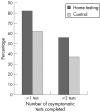Home screening for sexually transmitted diseases in high-risk young women: randomised controlled trial
- PMID: 17301105
- PMCID: PMC2598665
- DOI: 10.1136/sti.2006.023762
Home screening for sexually transmitted diseases in high-risk young women: randomised controlled trial
Abstract
Objective: Home screening tests could eliminate several barriers to testing sexually transmitted diseases (STDs).
Aim: To determine whether offering repeated home screening tests would increase the rate of testing for chlamydia and gonorrhoea in a high-risk sample of young women.
Methods: In this randomised controlled trial, 403 young women (mean age 18.9 years, 70% black) with a recent STD or with STD-related risk factors were enrolled. Participants were recruited from clinics and high-prevalence neighbourhoods and then randomly assigned to receive either a home testing kit or an invitation to attend a medical clinic for testing at 6, 12 and 18 months after enrollment. Over 80% of women were followed for 2 years. The trial is registered with ClinicalTrials.gov, number NCT 00177437.
Results: Of 197 women in the intervention group, 140 (71%) returned at least one home test and 25 of 249 (10%) home tests were positive. Women who received home screening tests completed significantly more STD tests overall (1.94 vs 1.41 tests per woman-year, p<0.001) and more STD tests in the absence of symptoms (1.18 vs 0.75 tests per woman-year, p<0.001). More women in the intervention group completed at least one test when asymptomatic (162 (82.2%) vs 117 (61.3%), p<0.001). The intervention was most effective among women recruited outside medical clinics. There was no significant difference in the overall rate of STDs detected.
Conclusions: Home screening significantly increased the utilisation of chlamydia and gonorrhoea testing in this sample of high-risk young women, and thus represents a feasible strategy to facilitate STD testing in young women.
Trial registration: ClinicalTrials.gov NCT00177437.
Conflict of interest statement
Competing interests: None declared.
References
-
- World Health Organization Global prevalence and incidence of selected curable sexually transmitted diseases: overview and estimates. Geneva: WHO, 2001
-
- Centers for Disease Control and Prevention Sexually transmitted disease surveillance 2004. Atlanta, GA: US, Department of Health and Human Services, Centers for Disease Control and Prevention 2005
-
- Centers for Disease Control and Prevention Sexually transmitted diseases treatment guidelines 2006. MMWR Recomm Rep. 2006;55(No. RR‐11). - PubMed
Publication types
MeSH terms
Associated data
LinkOut - more resources
Full Text Sources
Medical
Research Materials


